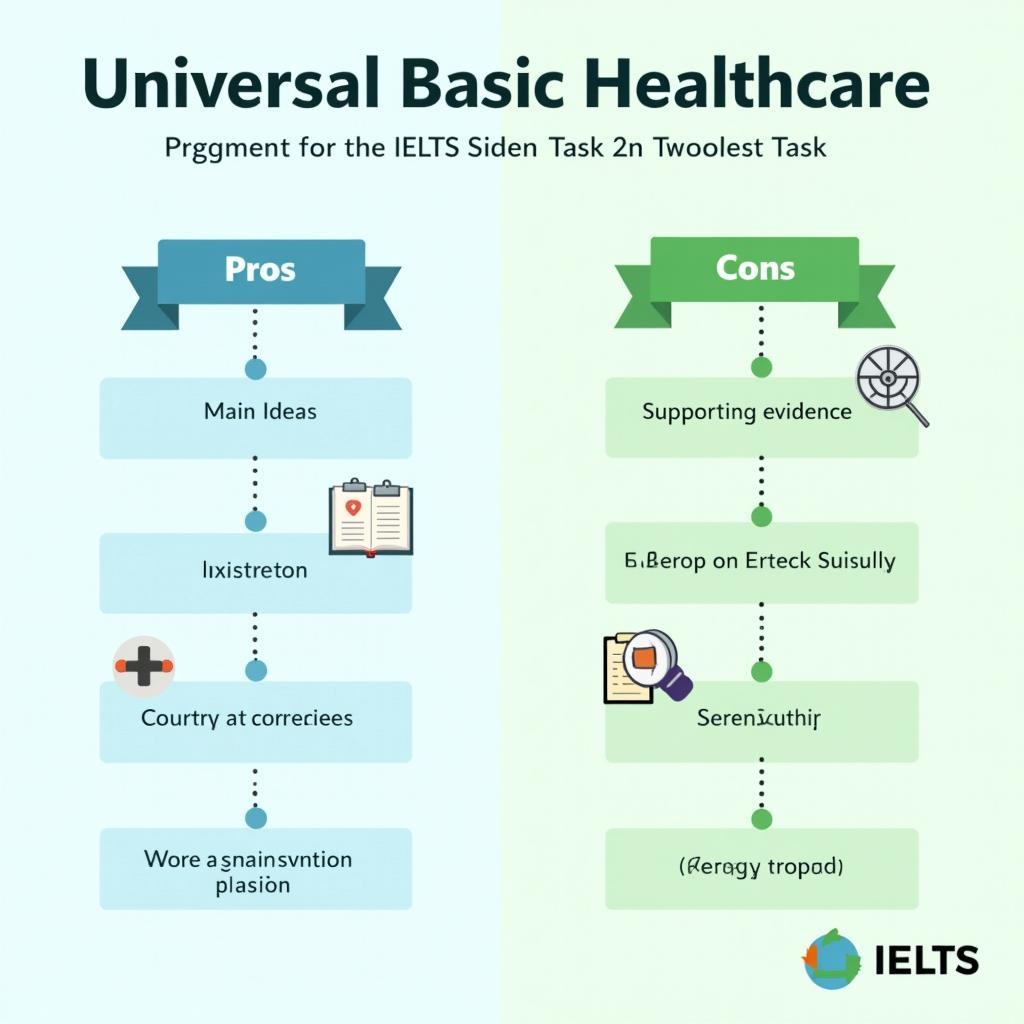Mở bài
Chủ đề Impact Of Virtual Learning On Traditional Education Systems xuất hiện thường xuyên trong IELTS Writing Task 2 từ giai đoạn 2020 đến nay, đặc biệt sau thời kỳ học trực tuyến bùng nổ. Đây là nhóm đề về giáo dục và công nghệ, thường hỏi theo dạng “positive/negative development” hoặc “agree/disagree”. Trong bài này, bạn sẽ nhận được 3 bài mẫu (Band 5-6, 6.5-7 và 8-9), phân tích chấm điểm chi tiết theo 4 tiêu chí, danh sách từ vựng chủ đề, 6 cấu trúc câu dễ ăn điểm, cùng checklist tự đánh giá khi luyện viết.
Nội dung bài viết
- Mở bài
- 1. Đề Bài và Phân Tích
- 2. Bài mẫu Band 8-9
- Phân tích Band điểm
- Các yếu tố giúp bài này được chấm điểm cao
- 3. Bài mẫu Band 6.5-7
- Phân tích Band điểm
- So sánh với bài Band 8-9
- 4. Bài mẫu Band 5-6
- Phân tích Band điểm
- Những lỗi sai của bài – phân tích & giải thích
- Cách Cải Thiện Từ Band 6 Lên Band 7
- 5. Từ vựng quan trọng cần nhớ
- 6. Cấu trúc câu dễ ăn điểm cao
- 7. Checklist Tự Đánh Giá
- Kết bài
Các đề thi thực tế liên quan đã được đăng/báo cáo bởi nguồn uy tín như IELTS Liz, IELTS-Blog, British Council/IDP dưới dạng đề thi gần đây hoặc đề luyện chính thức:
- Many universities offer online courses as an alternative to classes on campus. Do you think this is a positive or negative development? (được đăng trên IELTS Liz; cũng xuất hiện như đề báo cáo trên IELTS-Blog)
- Online learning is becoming increasingly popular. Some people claim it has more benefits than drawbacks. To what extent do you agree or disagree? (được báo cáo thường xuyên trên IELTS-Blog)
- Some people believe online education will replace traditional schools in the future. To what extent do you agree or disagree? (đề dạng báo cáo, biến thể phổ biến trên IELTS-Blog/IDP practice)
Trong bài, tôi chọn đề đầu tiên vì mức độ phổ biến và phạm vi phân tích rộng, sát với từ khóa impact of virtual learning on traditional education systems.
 Ảnh minh họa ảnh hưởng học trực tuyến tới hệ giáo dục truyền thống
Ảnh minh họa ảnh hưởng học trực tuyến tới hệ giáo dục truyền thống
1. Đề Bài và Phân Tích
Many universities offer online courses as an alternative to classes on campus. Do you think this is a positive or negative development?
Dịch đề: Nhiều trường đại học cung cấp các khóa học trực tuyến như một lựa chọn thay thế cho lớp học trực tiếp tại trường. Bạn cho rằng đây là một sự phát triển tích cực hay tiêu cực?
Phân tích đề bài:
- Dạng câu hỏi: Opinion/Positive or Negative Development. Bạn cần chọn lập trường rõ ràng (mostly positive/mostly negative/overall balanced but leaning).
- Thuật ngữ quan trọng:
- Online courses/virtual learning: học qua nền tảng số (LMS, video, MOOC).
- On campus: học trực tiếp tại trường.
- Alternative: lựa chọn thay thế (không nhất thiết thay thế hoàn toàn).
- Lỗi thường gặp:
- Lạc đề khi chỉ bàn về “công nghệ nói chung” mà không gắn với giáo dục đại học.
- Trả lời kiểu “both sides” nhưng không chốt quan điểm.
- Liệt kê ưu nhược điểm mà thiếu phát triển luận điểm, ví dụ, hệ quả.
- Dùng sai affect/effect; mạo từ a/an/the; giới từ in/at/on; thì hiện tại đơn/quá khứ đơn khi nêu thực trạng/quan điểm chung.
- Cách tiếp cận chiến lược:
- Chọn lập trường sớm (e.g., tích cực nhìn chung, với caveats).
- Dàn ý 2 thân bài: B1 – lợi ích (tiếp cận, linh hoạt, chi phí); B2 – rủi ro và cách giảm thiểu (chất lượng, tương tác, bất bình đẳng số).
- Kết luận nhấn mạnh tính “complementary” (bổ trợ), không “replacement” (thay thế hoàn toàn).
 Phân tích đề thi IELTS về online learning, yêu cầu và chiến lược làm bài
Phân tích đề thi IELTS về online learning, yêu cầu và chiến lược làm bài
2. Bài mẫu Band 8-9
Bài Band 8-9 nổi bật ở luận điểm nhất quán, phát triển ý sâu với ví dụ/logic rõ ràng, từ vựng học thuật chính xác và cấu trúc câu đa dạng, văn phong tự nhiên.
Essay (≈ 300 words):
In recent years, universities have increasingly delivered courses online, inviting debate about whether this shift represents a positive or negative development. While virtual learning undeniably introduces new risks, it is overwhelmingly beneficial when used to complement—rather than replace—on‑campus education.
The foremost advantage is expanded access. Online programmes enable working adults, caregivers, and rural learners to participate in higher education without relocating or sacrificing income. For example, part‑time modules and recorded lectures allow learners to study asynchronously, thus aligning education with diverse life schedules. A second benefit concerns cost and scalability: digital delivery can reduce facility overheads and permit wider enrolment without compromising admission standards. When designed around clear learning outcomes and robust assessment, virtual courses can match the rigour of campus-based ones.
Admittedly, e-learning can erode interaction and motivation if it relies on passive video consumption. Students may feel isolated, which undermines collaborative inquiry and critical discussion—hallmarks of traditional seminars. However, these shortcomings are not inherent to the medium. Interactive tools—live breakout rooms, discussion forums with tutor moderation, and authentic group projects—can recreate social presence. Moreover, concerns about academic integrity can be mitigated through authentic assessments (case studies, oral defenses, iterative portfolios) that evaluate process as much as product.
Ultimately, the debate is falsely binary. The most promising model is a blended ecosystem, where foundational content is delivered online while higher‑order learning—debate, labs, and mentorship—occurs on campus. Such a design preserves the relational strengths of traditional systems and leverages the flexibility and reach of virtual platforms. Therefore, online courses are a positive development, provided institutions invest in pedagogy, not just technology.
Phân tích Band điểm
| Tiêu chí | Band | Nhận xét |
|---|---|---|
| Task Response (Hoàn thành yêu cầu) | 8.5 | Trả lời trực diện câu hỏi “positive or negative”, lập trường rõ ràng “positive if complementary”. Luận điểm phát triển sâu, có điều kiện đi kèm và giải pháp. Không lạc đề, không bỏ sót khía cạnh. |
| Coherence & Cohesion (Mạch lạc & Liên kết) | 8 | Mở–Thân–Kết rõ ràng, chủ đề mỗi đoạn nhất quán. Dùng các nhãn diễn ngôn như “foremost”, “admittedly”, “ultimately” hợp lý. Liên kết logic chặt, không lạm dụng từ nối. |
| Lexical Resource (Từ vựng) | 8.5 | Vốn từ chủ đề phong phú: blended ecosystem, social presence, authentic assessments. Collocations chính xác, dùng từ sắc thái học thuật. Không lặp từ gây nhiễu. |
| Grammatical Range & Accuracy (Ngữ pháp) | 8 | Câu phức đa dạng, mệnh đề quan hệ, cụm phân từ, đảo ngữ nhẹ “not inherent to the medium”. Lỗi ngữ pháp không đáng kể; chấm câu linh hoạt. |
Các yếu tố giúp bài này được chấm điểm cao
- Quan điểm không cực đoan: nhấn mạnh “complement, not replace” → lập luận tinh tế.
- Dẫn chứng mang tính khái quát học thuật: authentic assessment, social presence, asynchronous learning.
- Dùng chiến thuật phản biện: chỉ ra nhược điểm rồi hóa giải với giải pháp cụ thể.
- Collocations mạnh: erode interaction, preserve relational strengths, leverage flexibility.
- Cấu trúc câu đa dạng: mệnh đề quan hệ, danh hóa (delivery, enrolment), cụm phân từ.
- Từ nối chuyển ý có logic, không lạm dụng: admittedly, ultimately.
 Bài mẫu Band 9 chủ đề virtual learning với từ vựng học thuật
Bài mẫu Band 9 chủ đề virtual learning với từ vựng học thuật
3. Bài mẫu Band 6.5-7
Đặc điểm: Lập luận đủ rõ, có ví dụ, nhưng độ tinh tế và chiều sâu lập luận chưa cao; từ vựng tốt nhưng còn lặp; lỗi nhỏ về collocation và mạo từ.
Essay (≈ 265 words):
Online courses have become a common option at many universities, and in my view this is mostly a positive development. It gives students more flexibility and access, although it should not replace traditional classrooms completely.
Firstly, virtual learning helps people who cannot attend campus. For instance, workers or parents can study in the evening, and students in remote areas do not need to move to big cities. This saves time and money and allows them to continue their jobs. In addition, recorded lectures and online materials make it easier to revise. When a course is well planned with clear goals and fair tests, studying online can reach a similar quality to face-to-face classes.
However, there are problems if everything is online. Students may feel lonely and less motivated, and they might only watch videos without real discussion. Group work can also be harder because people are in different time zones or have different internet speed. Another concern is cheating during exams, which makes the results less reliable. To solve these issues, universities should combine online content with live seminars and design assessments that require critical thinking, presentations, and teamwork.
In conclusion, I believe online courses are beneficial overall. They can widen opportunities and reduce costs, but they work best when used with traditional teaching. A blended approach can keep the advantages of both systems and improve learning outcomes for most students.
Phân tích Band điểm
| Tiêu chí | Band | Nhận xét |
|---|---|---|
| Task Response (Hoàn thành yêu cầu) | 7 | Trả lời rõ ràng “mostly positive”, có điều kiện và giải pháp. Một số ý còn khái quát, ví dụ chưa thật “đinh”. |
| Coherence & Cohesion (Mạch lạc & Liên kết) | 7 | Bố cục hợp lý, từ nối đủ dùng. Vẫn có lặp cấu trúc câu chủ đề. |
| Lexical Resource (Từ vựng) | 6.5 | Từ vựng liên quan đến e-learning tương đối đa dạng nhưng có lặp (online, videos). Collocations đôi chỗ chưa sâu (fair tests). |
| Grammatical Range & Accuracy (Ngữ pháp) | 7 | Câu phức có dùng nhưng chủ yếu dạng cơ bản. Ít lỗi, ngữ pháp nhìn chung chính xác. |
So sánh với bài Band 8-9
- Bài 8-9 dùng thuật ngữ học thuật hơn (social presence, authentic assessments) và phát triển lập luận phản biện sâu; bài 6.5-7 diễn đạt đúng nhưng chung chung hơn.
- Tổ chức ý: Bài 8-9 có logic “problem → not inherent → solution” rất sắc; bài 6.5-7 nêu vấn đề và giải pháp nhưng chưa chứng minh tính tất yếu.
- Ngôn ngữ: Bài 8-9 đa dạng cấu trúc và collocations; bài 6.5-7 an toàn, ít cấu trúc nâng cao.
4. Bài mẫu Band 5-6
Đặc điểm: Có ý nhưng phát triển hạn chế, lặp từ, lỗi ngữ pháp/word choice rõ, mơ hồ về lập trường; liên kết chưa mượt.
Essay (≈ 255 words):
Nowadays many universities give online courses and I think this is good but also bad in some ways. Some students like it and some do not, so it depends on different people and situations.
On the positive side, online learning is convenient. Students can stay at home and save time for travel. They can watch video many times and download materials. It is also cheaper because the school does not need many classrooms. For example, in my cousin’s university, many classes are on Zoom and he can study when he wants. So this is very helpful and make education more modern.
However, there are big problems. Students become lazy because they are not in the class and teachers cannot control them. Also, internet is not stable, so they miss lessons. Group work is difficult because everyone is busy and they don’t meet. Some students cheat in online exams, which is unfair for others and reduce the quality of education. Traditional education is better because it is real contact and students can ask question immediately.
In conclusion, online courses have pros and cons. In my opinion, it is better to use both online and traditional. Schools should make rules to stop cheating and make better internet so students can study more effective.
Phân tích Band điểm
| Tiêu chí | Band | Nhận xét |
|---|---|---|
| Task Response (Hoàn thành yêu cầu) | 6 | Có trả lời nhưng lập trường mơ hồ, phát triển ý chưa sâu, ví dụ đơn giản, khái quát. |
| Coherence & Cohesion (Mạch lạc & Liên kết) | 6 | Có bố cục cơ bản, nhưng nhiều câu rời rạc; từ nối hạn chế, lặp từ. |
| Lexical Resource (Từ vựng) | 5.5 | Từ vựng nghèo, lặp “online”, “students”, “class”. Dùng sai/thiếu tự nhiên một số chỗ (make education more modern). |
| Grammatical Range & Accuracy (Ngữ pháp) | 5.5 | Lỗi chia động từ, mạo từ, số ít/số nhiều; câu đơn lặp lại, ít cấu trúc phức. |
Những lỗi sai của bài – phân tích & giải thích
| Lỗi sai | Loại lỗi | Sửa lại | Giải thích |
|---|---|---|---|
| “watch video many times” | Danh từ số nhiều | watch videos many times | Video đếm được → số nhiều. |
| “make education more modern” | Collocation | modernise education / make education more up-to-date | Dùng động từ/collocation tự nhiên. |
| “internet is not stable” | Mạo từ/diễn đạt | the Internet is unreliable/unstable | Cần “the Internet” + tính từ phù hợp. |
| “ask question immediately” | Số nhiều/mạo từ | ask questions immediately | Questions ở dạng số nhiều trong ngữ cảnh chung. |
| “study more effective” | Tính từ/Trạng từ | study more effectively | Sau động từ cần trạng từ. |
| “he can study when he wants” | Mập mờ | he can study at flexible times/asynchronously | Diễn đạt học thuật, rõ nghĩa hơn. |
Cách Cải Thiện Từ Band 6 Lên Band 7
- Chốt lập trường rõ ràng ngay trong mở bài; tránh “it depends” nếu không phát triển được.
- Thêm chiều sâu: nêu cơ chế, hệ quả và cách khắc phục, không chỉ liệt kê.
- Nâng collocations học thuật: academic integrity, authentic assessment, learner autonomy, social interaction.
- Đa dạng cấu trúc câu: mệnh đề quan hệ, cụm phân từ, câu điều kiện loại hỗn hợp.
- Sửa lỗi cơ bản: mạo từ (the Internet), số ít/số nhiều, trạng từ vs tính từ, giới từ.
- Minh họa cụ thể: thay ví dụ cá nhân mơ hồ bằng ví dụ điển hình và có tính khái quát.
5. Từ vựng quan trọng cần nhớ
| Từ/Cụm từ | Loại từ | Phiên âm | Nghĩa tiếng Việt | Ví dụ (EN) và Collocations |
|---|---|---|---|---|
| virtual learning | n. | /ˈvɜːrtʃuəl ˈlɜːrnɪŋ/ | học trực tuyến | Virtual learning expands access for non-traditional students. Collocations: virtual classroom, virtual platform |
| blended learning | n. | /ˈblɛndɪd ˈlɜːrnɪŋ/ | học kết hợp | A blended learning model often yields better engagement. Collocations: blended model, blended ecosystem |
| asynchronous | adj. | /eɪˈsɪŋkrənəs/ | không đồng bộ | Asynchronous lectures allow flexible study. Collocations: asynchronous delivery |
| social presence | n. | /ˈsoʊʃl ˈprɛzəns/ | cảm nhận xã hội | Building social presence reduces isolation online. Collocations: foster social presence |
| academic integrity | n. | /ˌækəˈdɛmɪk ɪnˈtɛɡrəti/ | liêm chính học thuật | Authentic tasks promote academic integrity. Collocations: uphold/ensure academic integrity |
| authentic assessment | n. | /ɔːˈθentɪk əˈsesmənt/ | đánh giá thực | Oral defenses are an authentic assessment. Collocations: design authentic assessments |
| scalability | n. | /ˌskeɪləˈbɪləti/ | khả năng mở rộng | Online courses improve scalability. Collocations: improve/limit scalability |
| learner autonomy | n. | /ˈlɜːrnər ɔːˈtɒnəmi/ | tự chủ người học | Virtual formats can build learner autonomy. Collocations: promote learner autonomy |
| brick‑and‑mortar | adj. | /ˌbrɪk ən ˈmɔːrtər/ | truyền thống (cơ sở vật chất) | Brick‑and‑mortar seminars cultivate debate. Collocations: brick‑and‑mortar campus |
| digital divide | n. | /ˈdɪdʒɪtl dɪˈvaɪd/ | khoảng cách số | The digital divide can exclude rural learners. Collocations: bridge/widen the digital divide |
| erode interaction | v. phr. | /ɪˈroʊd ˌɪntərˈrækʃn/ | bào mòn tương tác | Passive videos may erode interaction. Collocations: erode engagement |
| leverage flexibility | v. phr. | /ˈlɛvərɪdʒ ˌflɛksəˈbɪləti/ | tận dụng tính linh hoạt | Schools can leverage flexibility of online tools. |
| to what extent | linker | /tə wɒt ɪkˈstɛnt/ | ở mức độ nào | To what extent do you agree with online learning? |
| provided that | linker | /prəˈvaɪdɪd ðæt/ | miễn là | Online is beneficial provided that quality is assured. |
| outweigh vs. outweighs | v. | /ˌaʊtˈweɪ/ | vượt trội hơn | The benefits outweigh the drawbacks. Collocations: significantly/clearly outweigh |
Lưu ý phát âm: chú ý trọng âm trong autonomy /ɔːˈtɒnəmi/ và asynchronous /eɪˈsɪŋkrənəs/.
6. Cấu trúc câu dễ ăn điểm cao
- Câu phức với mệnh đề phụ thuộc
- Công thức: Mệnh đề chính + liên từ phụ thuộc (because/although/while/if…) + mệnh đề phụ.
- Ví dụ (từ bài Band 8-9): Although e-learning can erode interaction, these shortcomings are not inherent to the medium.
- Vì sao ghi điểm: Tạo quan hệ nhân quả/nhượng bộ rõ ràng, tăng mạch lạc.
- Ví dụ bổ sung:
- While online courses expand access, they may intensify the digital divide.
- Because assessments are authentic, cheating becomes less feasible.
- Lỗi thường gặp: Dùng “Although but…”, thiếu chủ vị ở mệnh đề phụ.
- Mệnh đề quan hệ không xác định (non-defining)
- Công thức: Danh từ, which/who + mệnh đề bổ sung, …
- Ví dụ: …virtual platforms, which can match campus rigour when well designed, are widely adopted.
- Ghi điểm: Bổ sung thông tin tinh tế, dấu phẩy đúng.
- Ví dụ bổ sung:
- Traditional seminars, which encourage spontaneous debate, remain crucial.
- Online libraries, which are accessible 24/7, support independent study.
- Lỗi: Quên dấu phẩy; dùng “that” thay “which” trong không xác định.
- Cụm phân từ (participial phrases)
- Công thức: V-ing/V-ed + cụm, mệnh đề chính.
- Ví dụ: Designed around clear outcomes, online courses can match campus-based ones.
- Ghi điểm: Cô đọng, trang trọng.
- Ví dụ bổ sung:
- Leveraging synchronous tools, teachers can sustain engagement.
- Faced with connectivity issues, students may disengage.
- Lỗi: Treo chủ ngữ (dangling participle).
- Câu chẻ (Cleft sentences)
- Công thức: It is/was + thành phần nhấn mạnh + that/who + mệnh đề.
- Ví dụ: It is a blended ecosystem that preserves the strengths of both modes.
- Ghi điểm: Nhấn mạnh ý chính, tăng sức thuyết phục.
- Ví dụ bổ sung:
- It is academic integrity that many educators worry about.
- It is flexibility that attracts mature students.
- Lỗi: Lạm dụng; sai thì động từ.
- Câu điều kiện nâng cao
- Công thức: If/Unless/Provided that… + mệnh đề; dùng mixed conditionals/“provided that”.
- Ví dụ: Online learning is positive provided institutions invest in pedagogy.
- Ghi điểm: Tạo điều kiện ràng buộc rõ ràng, logic.
- Ví dụ bổ sung:
- If assessments were more authentic, cheating would decline.
- Unless support is offered, disadvantaged students may fall behind.
- Lỗi: Nhầm lẫn thì; dùng “if…will” trong mệnh đề điều kiện loại 1 không phù hợp ngữ cảnh.
- Đảo ngữ
- Công thức: Not only/No sooner/Under no circumstances + trợ động từ + S + V…
- Ví dụ: Not only does online delivery expand access, it also reduces overheads.
- Ghi điểm: Đa dạng hóa cấu trúc, nhấn mạnh.
- Ví dụ bổ sung:
- Under no circumstances should quality assurance be neglected.
- Rarely do online exams capture the full learning process.
- Lỗi: Sai trật tự trợ động từ; dấu phẩy không đúng.
7. Checklist Tự Đánh Giá
- Trước khi viết:
- Xác định dạng đề (agree/disagree; positive/negative).
- Chọn lập trường và 2-3 luận điểm mạnh nhất.
- Lập dàn ý: topic sentence → explanation → example → mini‑conclusion.
- Trong khi viết:
- Mở bài paraphrase gọn, chốt quan điểm rõ.
- Mỗi thân bài một ý chính, phát triển theo chuỗi logic.
- Dùng từ nối đa dạng; tránh lạm dụng “Firstly/Secondly”.
- Sau khi viết:
- Soát lỗi mạo từ, thì, giới từ; affect/effect; danh từ số nhiều.
- Kiểm tra tính nhất quán lập trường và trả lời đúng câu hỏi.
- Cắt bớt từ thừa; thay lặp từ bằng collocations.
- Mẹo quản lý thời gian:
- 3-4 phút phân tích đề + dàn ý; 30 phút viết; 3 phút soát lỗi.
- Viết thân bài trước nếu dễ; quay lại mở bài sau.
- Ưu tiên rõ ràng trước hoa mỹ.
[internal_link: Cách viết mở bài Task 2 theo từng dạng đề]
Kết bài
Chủ đề impact of virtual learning on traditional education systems đòi hỏi bạn không chỉ liệt kê ưu/nhược, mà còn phải chứng minh cơ chế và điều kiện để online học phát huy hiệu quả. Bài viết đã cung cấp 3 bài mẫu theo dải band 5-9, kèm chấm điểm chi tiết, từ vựng trọng tâm, 6 cấu trúc ăn điểm và checklist thao tác nhanh. Con đường cải thiện thực tế là luyện viết thường xuyên, nhận phản hồi có trọng tâm, và nâng dần độ tinh tế trong lập luận (từ “liệt kê” sang “phản biện + giải pháp”). Với kỷ luật 3 bài/tuần, hầu hết học viên có thể tăng 0.5 band sau 6-8 tuần.
Hãy thử viết lại đề đã chọn theo lập trường của bạn, chia sẻ ở phần bình luận để nhận góp ý từ cộng đồng. Nếu muốn mở rộng, bạn có thể luyện thêm các chủ đề gần như “technology in education”, “screen time and learning outcomes”, hoặc “education inequality in the digital age” để gia tăng phạm vi ý tưởng và từ vựng.
Tài nguyên nên xem: đề luyện từ IELTS Liz, báo cáo đề thi từ IELTS-Blog, và hướng dẫn chính thức từ British Council/IDP về band descriptors và cách chấm điểm. Tiếp tục tích lũy collocations, tối ưu cấu trúc, và luôn gắn lập luận với câu hỏi để chạm mốc band mục tiêu.



[…] số trong giáo dục, bạn có thể tham khảo bài viết liên quan: Tương tự như impact of virtual learning on traditional education systems, hiện tượng này cho thấy lợi ích đi kèm với khoảng cách tiếp cận công […]
[…] số hóa giáo dục, bạn có thể tham khảo thêm bài phân tích chuyên sâu về impact of virtual learning on traditional education systems; nội dung này giúp bạn lấy ví dụ thực tế và lập luận cân bằng hơn trong […]
[…] Để hiểu rõ hơn bức tranh chung, bạn có thể tham khảo bài phân tích chuyên sâu về tác động hệ thống: impact of virtual learning on traditional education systems […]